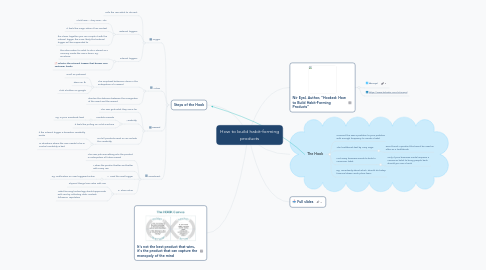
1. Steps of the Hook
1.1. Trigger
1.1.1. Tells the user what to do next
1.1.2. External triggers
1.1.2.1. "click here", "buy now", etc.
1.1.2.2. it feels like magic when it has context
1.1.2.3. the closer together you can couple it with the internal trigger the more likely that external trigger will be responded to
1.1.3. Internal triggers
1.1.3.1. the information for what to do is stored as a memory inside the user's brain, eg. emotions
1.1.3.2. What is the internal trigger that brings your customer back?
1.2. Action
1.2.1. The simpleset behaviour done in the anticipation of a reward
1.2.1.1. scroll on pinterest
1.2.1.2. share on fb
1.2.1.3. click a button on google
1.2.2. Shorten the distance between the recognition of the need and the reward
1.3. Reward
1.3.1. The user gets what they came for
1.3.2. Variability
1.3.2.1. variable rewards
1.3.2.1.1. eg. in your Facebook feed
1.3.2.2. it feels like pulling on a slot machine
1.3.3. Not all products need or can include the variability
1.3.3.1. if the internal trigger is boredom variability works
1.3.3.2. in situations where the user needs to be in control variability is bad
1.4. Investment
1.4.1. The user puts something into the product in anticipation of future reward
1.4.2. Makes the product better and better with every use
1.4.3. 1. Load the next trigger
1.4.3.1. eg. notification on user triggered action
1.4.4. 2. Store value
1.4.4.1. Physical things lose value with use
1.4.4.2. Habit forming technology should appreciate with use by collecting data, content, followers, reputation
2. It's not the best product that wins, it's the product that can capture the monopoly of the mind
3. Nir Eyal, Author, "Hooked: How to Build Habit-Forming Products"
3.1. @nireyal
3.2. https://www.linkedin.com/in/nireyal
4. The Hook
4.1. Connect the user's problem to your problem with enough frequency to create a habit
4.2. The toothbrush test by Larry Page
4.2.1. Don't touch a product that won't be used as often as a toothbrush
4.3. Not every business needs to build a consumer habit
4.3.1. Only if your business model requires a consumer habit to bring people back should you use a hook
